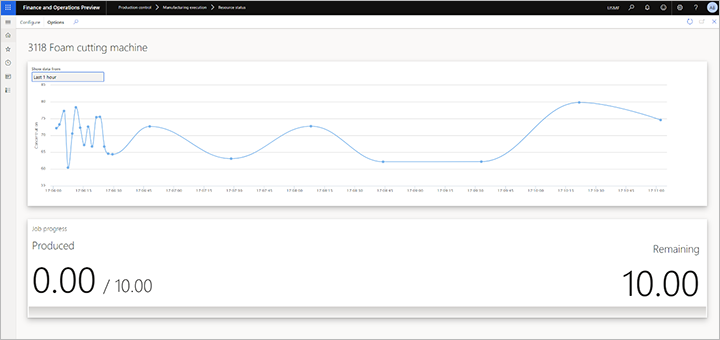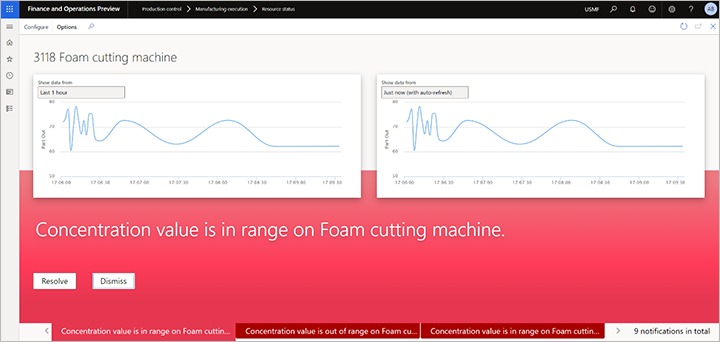Product quality scenario (preview)
[This article is prerelease documentation and is subject to change.]
In the product quality scenario, a sensor is set up to measure the quality of a product batch on the shop floor. If a measurement falls outside a defined threshold for the product, a notification is shown on the supervisor's dashboard. For example, a sensor is measuring the moisture of a food product that comes out of the production line. If the measurement is outside the allowed minimum or maximum value for moisture for the product, a notification is generated.
Scenario dependencies
The product quality scenario has the following dependencies:
- An alert can be triggered only if a production order is running on a mapped machine, and if that machine is producing a product that has a mapped batch attribute.
- A signal that represents the batch attribute must be sent to the IoT hub, and a unique property name must be included.
Prepare demo data for the product quality scenario
If you want to use a demo system to test the product quality scenario, use a system where the demo data is installed, select the USMF legal entity (company), and prepare the additional demo data as described in this section. If you're using your own sensors and data, you can skip this section.
In this section, you will set up the demo data so that you can use released product P0111 (Composite Case) with the product quality scenario. In this scenario, the system tracks whether a batch attribute value that is measured by a sensor is outside the defined threshold for a batch attribute that is associated with the product.
Set up a sensor simulator
If you want to try this scenario without using a physical sensor, you can set up a simulator to generate the required signals. For more information, see Set up a simulated sensor for testing.
Associate a batch attribute and resource with product P0111
Follow these steps to associate a batch attribute with product P0111 (Composite Case) and verify that resource 3118 (Foam cutting machine) is used for it.
Go to Product information management > Products > Released products.
Find and select the product where the Item number field is set to P0111.
On the Action Pane, on the Manage inventory tab, in the Batch attributes group, select Product specific.
On the Product specific page, select New to create a product-specific batch attribute.
On the header, set the following fields:
- Attribute code – Select the scope of attributes that you will monitor (Table, Group, or All). For this scenario, select Table, because you will always monitor a single attribute.
- Attribute relation – Select the attribute that you will use the product quality scenario to monitor the value of. For this example, select Concentration, which is an attribute that is included in the standard demo data.
On the Values FastTab, in the Minimum and Maximum fields, define the range of acceptable values that the attribute must report to pass the quality check. If the sensor reports a value outside this range, the system will identify it as a quality violation. The other fields on this FastTab aren't relevant to the product quality scenario. The default values that you currently see come from the demo data. Therefore, leave them as they are, and close the Product specific page to return to the Released product details page for item P0111.
On the Action Pane, on the Engineer tab, in the View group, select Route.
On the Route page, on the Overview tab at the bottom of the page, select the line where the Oper. No. field is set to 30.
On the Resource requirements tab at the bottom of the page, make sure that resource 3118 (Foam cutting machine) is associated with the operation.
Create and release a production order for product P0111
Follow these steps to create and release a production order for product P0111.
Go to Production control > Production orders > All production orders.
On the All production orders page, on the Action Pane, select New batch order.
In the Create batch dialog box, set the following values:
- Item number: P0111
- Quantity: 10
Select Create to create the order and return to the All production orders page.
Use the Filter field to search for production orders where the Item number field is set to P0111. Then find and select the production order that you just created.
On the Action Pane, on the Production order tab, in the Process group, select Estimate.
In the Estimate dialog box, select OK to run the estimate.
On the Action Pane, on the Production order tab, in the Process group, select Release.
In the Release dialog box, make a note of the number of the batch order that you just created.
Select OK to release the order.
Configure the production floor execution interface
If you haven't already done so, configure the production floor execution interface to show jobs that are assigned to resource 3118 (Foam cutting machine). For instructions, see the following sections:
- Configure the production floor execution interface
- Enable search option on the production floor execution interface
Start the first job in the batch order
Follow these steps to start the first job in the batch order.
- Go to Production control > Manufacturing execution > Production floor execution.
- In the Badge ID field, enter 123. Then select Sign in.
- If you're prompted for an absence reason, select one of the cards for absence, and then select OK.
- In the Search field, enter the batch order number that you previously made a note of. Then select the Return key.
- Select the order, and then select Start job.
- In the Start job dialog box, select Start.
Set up the product quality scenario
Follow these steps to set up the product quality scenario in Supply Chain Management.
Go to Production control > Setup > Sensor Data Intelligence > Scenarios.
In the Product quality scenario box, select Configure to open the setup wizard for this scenario.
On the Sensors page, select New to add a sensor to the grid. Then set the following fields for it:
- Sensor ID – Enter the ID of the sensor that you're using. (If you're using the Raspberry PI Azure IoT Online Simulator and have set it up as described in Set up a simulated sensor for testing, enter Quality.)
- Sensor description – Enter a description of the sensor.
Repeat the previous step for each additional sensor that you want to add now. You can come back and add more sensors at any time.
Select Next.
On the Business record mapping page, in the Sensors section, select the record for one of the sensors that you just added.
In the Business record mapping section, select New to add a row to the grid.
On the new row, the Business record type field should automatically be set to Resources(WrkCtrTable). Set the Business record field to the resource that you're using the selected sensor to monitor. (If you're using the demo data that you created earlier in this article, set it to 3118, Foam cutting machine.)
Immediately after you select a business record type for the row that you added in the previous step, a second row is automatically added to the grid. On this row, the Business record type field should be set to Batch attributes(PdsBatchAttrib). Set the Business record field to the batch attribute that you're using the selected sensor to monitor. (If you're using the demo data that you created earlier in this article, set it to Concentration, Concentration Percentage.)
Select Next.
On the Activate sensors page, in the grid, select the sensor that you added, and then select Activate. For each activated sensor in the grid, a check mark appears in the Active column.
Select Finish.
Work with the product quality scenario
View product quality data on the Resource status page
On the Resource status page, supervisors can monitor a timeline of the product quality signal that is received from the sensors that are mapped to each machine resource. Follow these steps to configure the timeline.
Go to Production control > Manufacturing execution > Resource status.
In the Configure dialog box, set the following fields:
- Resource – Select the resources that you want to monitor. (If you're working with the demo data, select 3118.)
- Time series 1 – Select the record (metric key) that has the following format for its name: ProductQuality:<JobId>:<AttributeName>
- Display name – Enter Batch attribute values.
The following illustration shows an example of product quality data on the Resource status page when the value is in the range of acceptable values.

The following illustration shows an example of product quality data when an out-of-range value is detected.

View product quality data on the Notifications page
On the Notifications page, supervisors can view the notification that are generated when the sensor measures a batch attribute value that falls outside the defined threshold for the batch attribute. Each notification provides an overview of the production job that is affected by the outage and gives the option to reassign the affected job to another resource.
To open the Notification page, go to Production control > Inquiries and reports > Sensor Data Intelligence > Notifications.
The following illustration shows an example of a product quality notification.

Povratne informacije
Stiže uskoro: Tijekom 2024. postupno ćemo ukinuti servis Problemi sa servisom GitHub kao mehanizam za povratne informacije za sadržaj i zamijeniti ga novim sustavom za povratne informacije. Dodatne informacije potražite u članku: https://aka.ms/ContentUserFeedback.
Pošaljite i pogledajte povratne informacije za